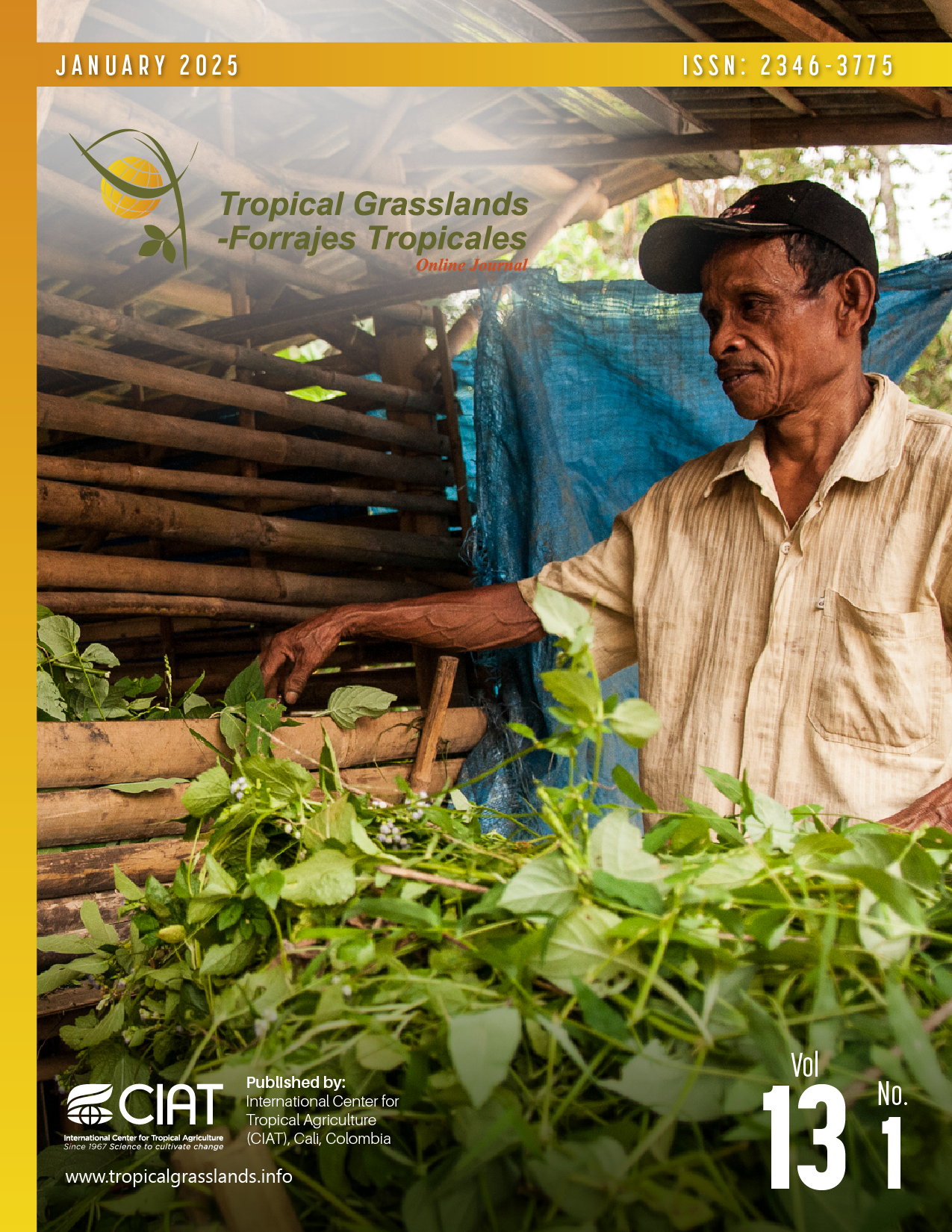Evaluación de leguminosas herbáceas para sistemas cultivos-ganadería en el este de Indonesia
DOI:
https://doi.org/10.17138/tgft(13)7-27Resumen
La venta de ganado representa una oportunidad importante para mejorar los medios de vida de los pequeños agricultores en el este de Indonesia. Se identificó una oportunidad para cultivar leguminosas forrajeras herbáceas en rotación con, o sembradas en asocio, con cereales (maíz, arroz), para utilizar la humedad excedente del suelo para producir un banco de alimento para el ganado (en su mayoría estabulados) y potencialmente aumentar el suministro de nitrógeno a los cultivos de cereales. Se realizó una serie de experimentos en suelos Vertisol, Alfisol e Inceptisol en distritos de tierras bajas y altas del este de Indonesia para identificar leguminosas de 18 taxones adecuadas para sistemas integrados de cultivos y forrajes. Se encontró que Clitoria ternatea y Centrosema pascuorum tenían el mejor potencial para estos sistemas, ya que se establecieron de manera confiable utilizando métodos locales, ocuparon un lugar destacado en cuanto a rendimiento de forraje de 2 a 4 meses después de la siembra y fueron relativamente fáciles de cosechar. Los rendimientos fueron más altos en los Vertisoles (mayor número de sitios) e Inceptisoles. Lablab purpureus, Macroptilium bracteatum y Mucuna pruriens también obtuvieron una alta calificación en cuanto a rendimiento en Vertisoles. Clitoria ternatea fue consistente en rebrotar después del corte y la extracción del forraje, lo que brinda potencial para una producción prolongada de forraje cuando se presentan condiciones adecuadas para su crecimiento.
Referencias bibliográficas
Akobundu IO; Okigbo BN. 1984. Preliminary evaluation of ground covers for use as live mulch in maize production. Field Crops Research 8:177–186. doi: 10.1016/0378-4290(84)90061-3
Ayre-Smith R. 1991. Livestock development in NTT. In: Barlow C; Bellis A; Andrews K, eds. 1991. Nusa Tenggara Timur: The challenges of development. Political and Social Change Monograph 12. Department of Political and Social Change, Research School of Pacific Studies, The Australian National University, Canberra, ACT, Australia. p. 85–104. hdl.handle.net/1885/132906
Bell LW; Hossang EY; Traill SR; Dalgliesh NP; Budisantoso E; Nulik J. 2022. Short phases of tropical forage legumes increase production of subsequent cereal crops in the seasonally dry tropics of eastern Indonesia. European Journal of Agronomy 132:126406. doi: 10.1016/j.eja.2021.126406
Bell LW; Mayberry D; Cox K; Traill S; Nulik J; Hosang E; Kana Hau D. 2020. Integrating herbaceous forage legumes into crop and livestock systems in East Nusa Tenggara, Indonesia. Final Report, ACIAR Project LPS/2012/064. Australian Centre for International Agricultural Research (ACIAR), Canberra, ACT, Australia. bit.ly/40bObuP
Budisantoso E; Fernandez P. Th; Nulik J. 2006. Integrating short term legume leys into the maize cropping systems in West Timor: species adaptation evaluation. Proceedings of national seminars BBP2TP, Badan Litbang Pertanian, Kupang, Indonesia, 26–27 July 2006. p. 516–528.
Budisantoso E; Dalgliesh N; Fernandez PTh; Basuki T; Hosang E; Kana Hau D; Nulik J. 2008. The utilization of stored soil moisture for forage legumes supply in the dry season in West Timor, Indonesia. In: Proceedings of the 21st International Grasslands Congress, Hohhot, China, 29 June–5 July 2008. bit.ly/404SYy9
Burrows DM; Porter FJ. 1993. Regeneration and survival of Desmanthus virgatus 78382 in grazed and ungrazed pastures. Tropical Grasslands 27(2):100–107. bit.ly/3Pp5fZn
Cameron AG. 2005. Centrosema pascuorum in Australia’s Northern Territory: a tropical forage legume success story. Tropical Grasslands 39(4):219. bit.ly/3DJon1n
Central Bureau of Statistics. 2019. Nusa Tenggara Timur Province in Figures 2019. Internal Report, Kupang, Indonesia. (In Indonesian). bit.ly/42wigYH
Clements RJ; Winter WH; Reid R. 1984. Evaluation of some Centrosema species in small plots in northern Australia. Tropical Grasslands 18(2):83–91. bit.ly/39shLQs
Clem RL; Hall TJ. 1994. Persistence and productivity of tropical pasture legumes on three cracking clay soils (vertisols) in north-eastern Queensland. Australian Journal of Experimental Agriculture 34(2):161–171. doi: 10.1071/EA9940161
Cook BG; Pengelly BC; Schultze-Kraft R; Taylor M; Burkart S; Cardoso Arango JA; González Guzmán JJ; Cox K; Jones C; Peters M. 2020. Tropical Forages: An interactive selection tool. 2nd and Revised Edn. International Center for Tropical Agriculture (CIAT), Cali, Colombia and International Livestock Research Institute (ILRI), Nairobi, Kenya. tropicalforages.info
Dalgliesh N; Nulik J; Cox K; Poulton P. 2014. Integrating herbaceous forage legumes into the maize cropping systems of West Timor. Final report, ACIAR Project LPS/2006/003. Australian Centre for International Agricultural Research (ACIAR), Canberra, ACT, Australia. bit.ly/4j9fJtu
Dalgliesh N; Nulik J; Quigley S; Fernandez P; Rubianti A; Kana Hau D; Suek J; Darbas T; Budisantoso E; Poppi D. 2010. The use of forage legumes in cereal cropping systems of eastern Indonesia. In: Proceedings of the 15th Animal Science Association Conference, Lincoln, New Zealand, 15–19 November 2010. bit.ly/4jaWpMf
Edye LA; Hall TJ; Clem RL; Graham TWG; Messer WB; Rebgetz RH. 1998. Sward evaluation of eleven “Stylosanthes seabrana” accessions and S. scabra cv. Seca at five subtropical sites. Tropical Grasslands 32(4):243–251. bit.ly/4h24FMK
Hall TJ. 1985. Adaptation and agronomy of Clitoria ternatea L. in northern Australia. Tropical Grasslands 19(4):156–163. bit.ly/40pgWFH
Hartutik S; Fernandez P; Ratnawaty S. 2012. Evaluation of legume herbs nutritive value as ruminant feed and nitrogen supply on soil in west Timor, Indonesia. Pakistan Journal of Agricultural Research 25(4):323–331. bit.ly/4h33w7G
Jones RM; Brandon NJ. 1998. Persistence and productivity of eight accessions of Desmanthus virgatus under a range of grazing pressures in subtropical Queensland. Tropical Grasslands 32(3):145–152. bit.ly/39luAvP
Jones RM; Bishop HG; Clem RL; Conway MJ; Cook BG; Moore K; Pengelly BC. 2000. Measurements of nutritive value of a range of tropical legumes and their use in legume evaluation. Tropical Grasslands 34(2):78–90. bit.ly/2WMzAqx
Mannetje ‘t L. 1997. Harry Stobbs Memorial Lecture, 1994. Potential and prospects of legume-based pastures in the tropics. Tropical Grasslands 31(2):81–94. bit.ly/3DIIRHR
Mayberry D; Kana Hau D; Dida PR; Bria D; Praing J; Mata AD; Budisantoso E; Dalgliesh N; Quigley S; Bell L; Nulik J. 2021. Herbaceous legumes provide several options for increasing beef cattle productivity in eastern Indonesia. Animal Production Science 61(7):698–707. doi: 10.1071/AN20545
Nulik J. 1987. Evaluation of exotic grasses and legumes for use in pastures in Eastern Indonesia. M. Rur. Sc. Thesis. The University of New England, Armidale, Australia.
Nulik J; Dalgliesh N; Cox K; Gabb S. 2013. Integrating herbaceous legumes into crop and livestock systems in eastern Indonesia. ACIAR Monograph No. 154. Australian Centre for International Agricultural Research (ACIAR), Canberra, ACT, Australia. 130 p. bit.ly/3XP4oTS
Nulik J; Hosang E; Kana Hau D; Liunokas Y; Aby Y; Uran Y; Cox K. 2016. The influence of sowing date and trellising on the flowering of some promising herbaceous legumes for eastern Indonesia. In: Proceedings of the 17th Asian-Australasian Association of Animal Production Societies, Fukuoka, Japan, 22–25 August 2016. p. 734–737. bit.ly/3W9LE2W
Nulik J; Bell L; Cox K; Kana Hau D; Hosang E; Rebo R; Liunokas Y; Abi Y; Uran J. 2017. The effect of sowing method, seed rate, planting time and weed management on the establishment of introduced herbaceous legumes in East Nusa Tengarra, Indonesia. In: Proceedings of the 18th Australian Society of Agronomy Conference, Ballarat, Australia, 24–28 September 2017. bit.ly/4gY0wK0
Peck G; Buck S; Hoffman A; Holloway C; Johnson B; Lawrence D; Paton C. 2011. Review of productivity decline in sown grass pastures. Final Report, Project B.NBP.0624. Meat and Livestock Australia (MLA), Melbourne, Australia. bit.ly/40nwQAe
Pengelly BC; Conway MJ. 2000. Pastures on cropping soils: which tropical pasture legume to use?. Tropical Grasslands 34(3–4):162–168. bit.ly/2yb8n6B
Piggin CM; Mell P; Janing M; Akhlis MS; Kerridge PC; Zaingo M. 1987. Results from pasture and forage trials, 1985–1987. Internal Report, East Nusa Tenggara Integrated Area Development Project, Kupang, Indonesia.
Piggin CM. 1991. New forage technologies. In: Barlow C; Bellis A; Andrews K, eds. 1991. Nusa Tenggara Timur: The challenges of development. Political and Social Change Monograph 12. Department of Political and Social Change, Research School of Pacific Studies, The Australian National University, Canberra, ACT, Australia. p. 105–120. hdl.handle.net/1885/132906
Regan CS. 1997. Forage conservation in the wet/dry tropics for small landholder farmers. MSc Thesis. Northern Territory University, Darwin, NT, Australia. doi: 10.25913/5e7c14042cde3
Soil Survey Staff. 1999. Soil taxonomy: A basic system of soil classification for making and interpreting soil surveys. 2nd edition. Agriculture Handbook No. 436. United States Department of Agriculture (USDA), Natural Resources Conservation Service, Washington, USA. bit.ly/4j9BTvG
VSN International. 2014. GenStat Statistical Package for Windows. 17th Edition. VSN International, Hemel Hempstead, United Kingdom.
Whitbread AM; Pengelly BC; Smith BR. 2005. An evaluation of three tropical ley legumes for use in mixed farming systems on clay soils in southern inland Queensland, Australia. Tropical Grasslands 39(1):9–21. bit.ly/2UtHB2d
Cómo citar
Descargas
Descargas
Publicado
Número
Sección
Licencia
Derechos de autor 2025 Tropical Grasslands-Forrajes Tropicales

Esta obra está bajo una licencia internacional Creative Commons Atribución 4.0.




